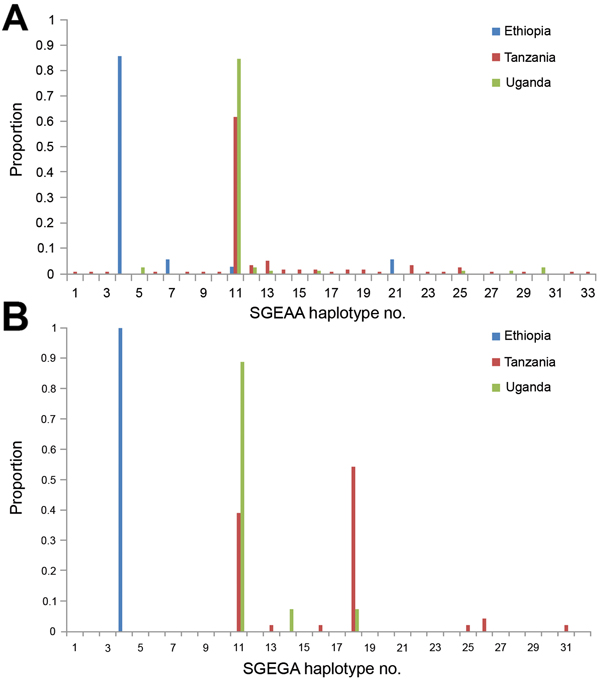Independent Origin of Plasmodium falciparum Antifolate Super-Resistance, Uganda, Tanzania, and Ethiopia
Michael Alifrangis
1, Sidsel Nag
1
, Mette L. Schousboe, Deus S. Ishengoma, John Lusingu, Hirva Pota, Reginald A. Kavishe, Richard Pearce, Rosalynn Ord, Caroline Lynch, Seyoum Dejene, Jonathan Cox, John Rwakimari, Daniel T.R. Minja, Martha M. Lemnge, and Cally Roper
Author affiliations: Centre for Medical Parasitology at Department of International Health, Immunology, and Microbiology, Faculty of Health and Medical Science, University of Copenhagen and at Department of Infectious Diseases, Copenhagen University Hospital (Rigshospitalet),; Copenhagen, Denmark (M. Alifrangis, S. Nag, M.L. Schousboe); Tanga Research Centre, Tanzania (D. Ishengoma, J. Lusingu, D.T.R. Minja, M.M. Lemnge); London School of Hygiene and Tropical Medicine, London, UK (H. Pota, R. Pearce, R. Ord, C. Lynch, J. Cox, C. Roper); Kilimanjaro Christian Medical University College, Moshi, Tanzania (R.A. Kavishe); Kilimanjaro Clinical Research Institute, Moshi (R.A. Kavishe); Médécins Sans Frontières, Humera, Ethiopia (S. Dejene); Ministry of Health of Uganda, Kampala, Uganda (J. Rwakimari)
Main Article
Figure

Figure. Proportion of microsatellite haplotypes linked to SGEAA and SGEGA, eastern AfricaMicrosatellite haplotypes associated with the Pfdhps double-mutant allele SGEAA (A) and Pfdhps triple-mutant allele SGEGA (B) in Ethiopia, Tanzania, and UgandaHaplotype numbering (x-axis) refers to a unique combination of microsatellite allele sizes at the 3 loci linked to dhps (specific microsatellite allele combinations are listed in the Technical Appendix Table, Proportion (y-axis) is the number of alleles associated with each microsatellite haplotype expressed as a proportion of the total number of alleles sampled in each country for which the associated microsatellite haplotype could be determined.
Main Article
Page created: July 18, 2014
Page updated: July 18, 2014
Page reviewed: July 18, 2014
The conclusions, findings, and opinions expressed by authors contributing to this journal do not necessarily reflect the official position of the U.S. Department of Health and Human Services, the Public Health Service, the Centers for Disease Control and Prevention, or the authors' affiliated institutions. Use of trade names is for identification only and does not imply endorsement by any of the groups named above.
